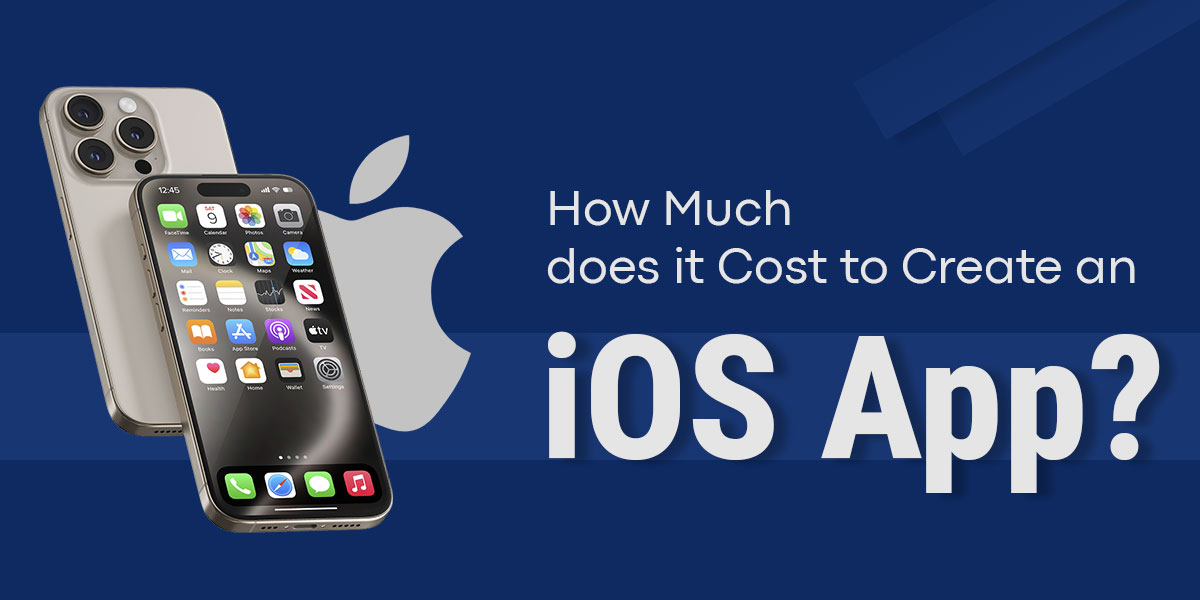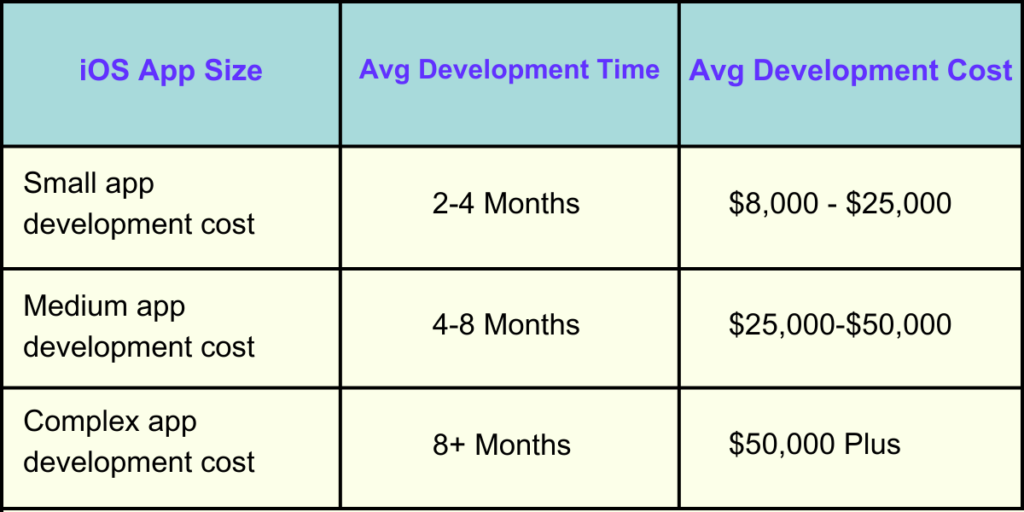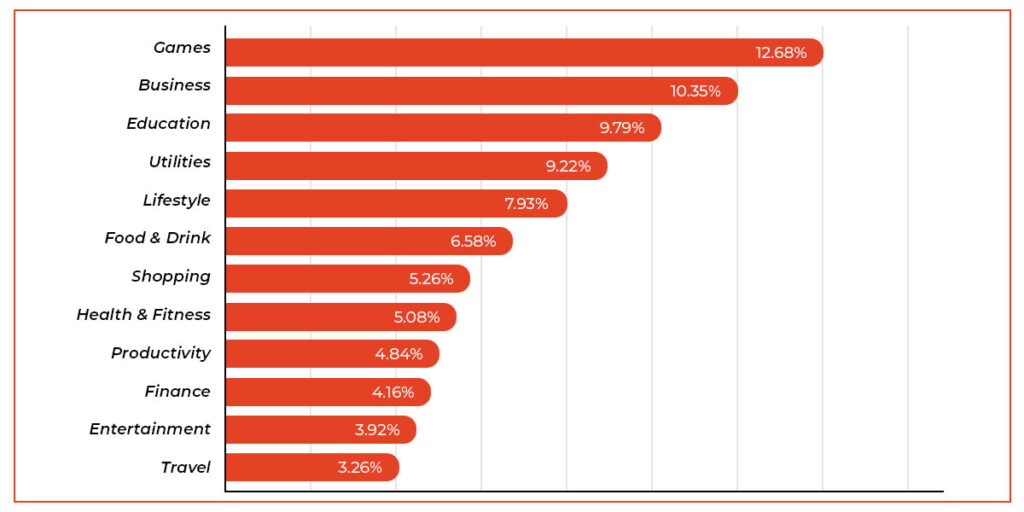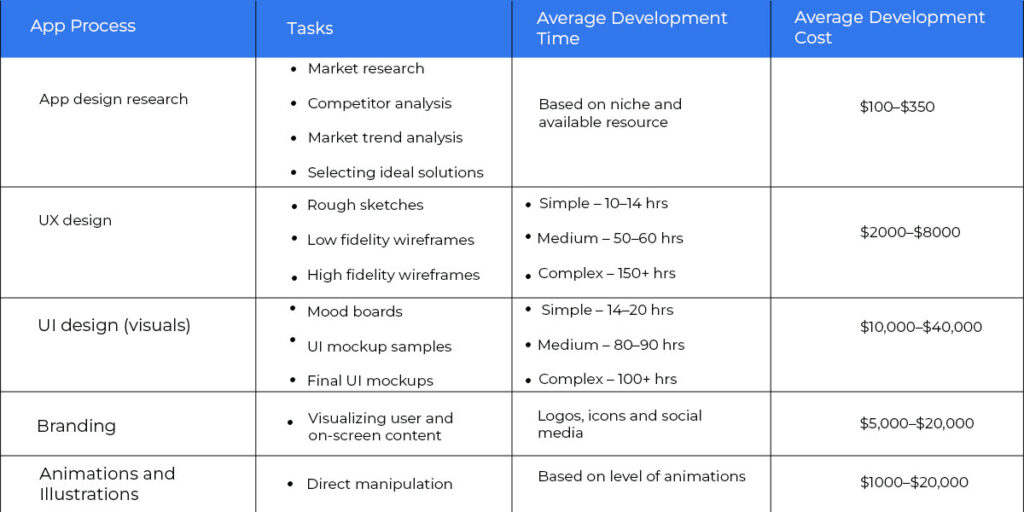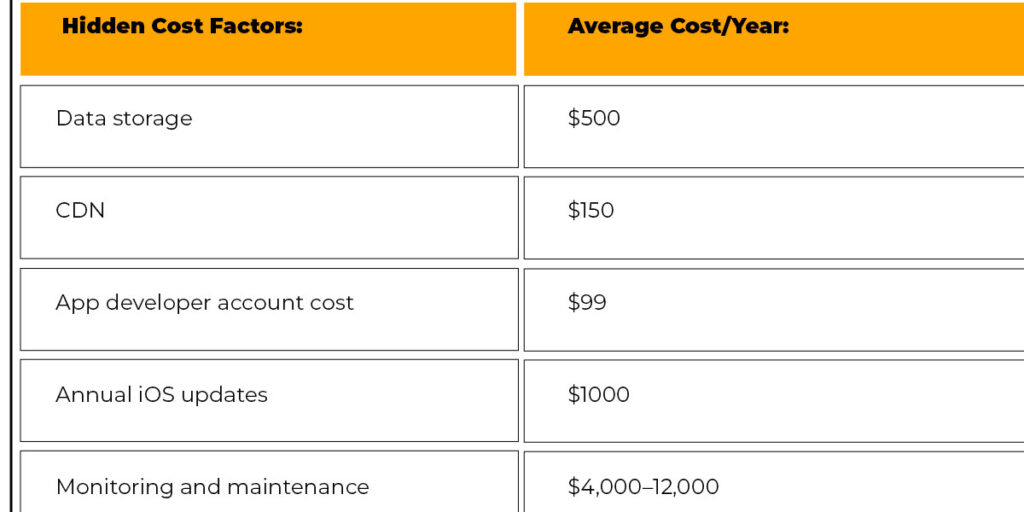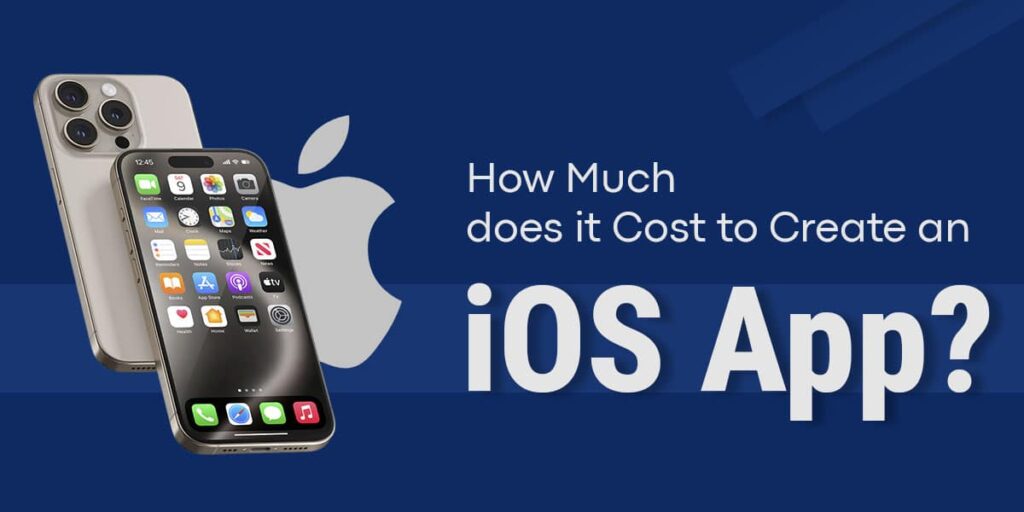
How Much Does It Cost to Develop an iOS App?
Are you an entrepreneur or business owner who has decided to choose iOS as an ideal platform for your mobile app development? Choosing iOS is a smart step to reach a premium audience, but before you launch your app, it’s normal to be worried about the iPhone app development costs. The cost of an iOS app ranges from $50,000 to $700,000, mainly depending on its size, design, features, complexity, hours of operation, and many other factors.
So, don’t take stress too much! We will answer all your questions in detail, from choosing the best iOS app development company to understanding the most important factors that affect your budget. A detailed comparison between Android and iOS app development costs will help you decide the right cost for an iOS app.
Let’s dive into everything you need to know about the cost before developing an iPhone App!
Formula for Estimating the Cost of Developing an iPhone App
Whether you make an iOS app or an Android app, the mobile app development cost always varies depending on various factors like the app size, UI/UX design, features, app complexity level, app category, development team location, and tech stacks.
Here is the Formula to calculate the iPhone App development cost:
Cost of iOS App Development: UI/UX design Hours + App Platform + [Hourly Rates of Developers x Development Time]
With the help of this formula, you will get a rough idea about the cost estimation for developing an iOS app. After your calculation is done, you can negotiate with the companies and easily hire a trusted iOS app development company and deploy your app successfully.
Key Factors Impacting iOS Development Cost
The cost of developing an iPhone app includes several factors that affect the app’s total costs and success. It is important to understand different factors when determining your iOS growth costs. There is an overview of all the main aspects here.
iOS App Size
When developing any mobile app, the app size matters in deciding the actual cost. As your iOS app size increases, more screens and functions, time, and costs increase. To ensure efficiency, start by validating your app idea and its functionality. This step helps to streamline development, avoid unnecessary complications, and focus on properties that improve the user experience.
Market research is equally important. Analyze competitors, study user preferences, and identify the feature to improve or hinder the purpose. Pay attention to the trends and normal pain points on the device. Learning from similar apps provides valuable insights, which help you create a prominent product, reduce the development risk.
In short, Large applications packed with advanced features and extensive content require more developmental time, effort, and resources; a little change makes them more expensive than the standard app.
On the other hand, small apps with limited functionality are suitable for a small budget, as they require low time to develop and streamlined coding efforts. Strategically, by balancing the app system and using effective coding practices, the app can customize the size that hold the costs.
Complexity of App Feature
The complexity of the features of an iOS app directly affects costs. Simple apps, which prefer essential functionality, are more cost-effective and sharp to develop. On the other hand, apps with moderate or complex features require more time, advanced resources and special development efforts, which cost high overall expenses.
Basic iOS App Features
Basic apps focus on fundamental features that provide a streamlined user experience. These usually include email or password logging, clean and simple user interfaces. Using standard authentication methods such as core functions, basic display, or easy task. A basic database user is integrated into data storage, and Push Notification helps users stay informed with notifications and updates.
Medium iOS App Features
Apps with Medium complexity include more advanced functionalities to increase engagement. This includes biometric login or integration of social media, a customized user interface, and additional features such as messages, search functions and a payment gateway. More sophisticated databases support large datasets, while analyzing User behavior to refine to perform device and customize storage strategies.
Complex iOS App Features
High-end iOS apps require advanced functionality and strong backend integration. They have advanced UI/UX design with multi-factor certification, role-based access control, and interactive animation and gesture-based navigation. Complex apps often include real-time collaborative tools, artificial intelligence propaganda, improved reality experience, and spontaneous synchronization with backend systems. Security measures such as data encryption and compliance with industry standards ensure the user’s safety and reliability.
By choosing carefully the correct convenience complexity level, companies can optimize growth costs when distributing a high-performing iOS app that meets the user’s expectations and is in a competitive market. It is important to balance innovation with a strategic plan and an intensive research budget, which ensures long-term success.
App Category
The cost of developing the iOS app varies depending on the app category. Each category comes with its own complexity levels, functions, and expectations of user experience – factors that affect the time and cost of direct development.
For example, apps such as games or e-commerce apps often include complex designs, complex functionality, and extensive studies, making them more expensive to build. In contrast, simple tools with basic functions usually require a short time and fewer resources, which reduces growth costs.
Further factors such as third-party integration, compliance with privacy regulations for data, and special development skills can also affect the total cost of an iOS app
Below you will find an image showing the most popular app categories in the App Store in 2026, as well as the market share.
Now, here is a broad overview of the costs of iOS app development according to the category
iOS App Design
When inspecting “what is the cost to develop an iOS app?”, the most important factor that cannot be ignored is the design and animation of the app. The complexity of UI/UX design, custom images, and motion graphics highly affects the total cost. And it’s natural that the more complex the design, the more investment is required.
This states that, visually attractive and user-friendly app design not only improves the user experience but also promotes engagement and conversion rates, a smart investment for long-term success.
Here are the top three iOS apps you should know:
Wireframing
It highlights the structure and user flow of the phase app. Tools such as Photoshop, Balsamiq and Marvel are usually used to create wireframes that work and navigation.
UI Design
iOS apps usually follow a flat design approach to ensure clean views and a smooth user experience. Unlike Android’s content design, iOS focuses on simplicity with depth and clarity. Learn more in our guide on iOS vs Android app design differences.
Animation
Alternatively, animation is important for some app types such as social media, food delivery and games. They add a layer of conversation and can increase the general user experience.
Below is a comprehensive summary of iOS app development costs based on your design and animation requirements:
API Integrations
When you calculate a budget for iOS app development, one of the most important factors is API integration. API (application programming interface) allows your app to interact with the external system for real-time data, payment processing, geo-localization or social media login. Type, volume, and complexity of these integrations can significantly affect total costs.
API integration cost in iOS App Development
API integration cost varies depending on several main factors:
- Number of API: Each new API adds integrated development time and test attempts.
- Complexity of API: More advanced APIs, such as real-time updates (eg, Stock Tracking, Logistics), require more backend architecture, which increases costs.
- Customization Requirements: API requires customized workflow, data formatting or extended functions, it takes longer to use and test.
- The Quality of the Documentation: A poorly documented API slows down the development. Well-documented APIs reduce errors and speed up integration.
- Ongoing Maintenance and Support: The API may require updates over time to stay compatible with iOS updates or backend changes, leading to recurring costs.
Example: Integrating a single weather API can cost below $ 500, while integration of a real-time logistics API with custom tracking features can be more than $ 3000.
Payment Gateway Integration Costs
For transactions, it is important to handle apps like e-commerce, financial or service-based platform payment gateway integration. Cost payments vary depending on the payment provider, level of security needed, and customization requirements.
Key Cost Driver
- Provider Options: Different Gateways offer different price models and features.
- Transaction Amount: You can qualify for high-volume discounts, but this can increase the total cost.
- Security compliance: Extra efforts and expenses are required to meet standards such as PCI DSS for secure transactions.
- Customization: Customizing the payment experience (eg, split payment, membership, tip functionality) increases the complication.
- Quick transfers: Services such as Apple Pay may charge fees for immediate money transfer.
Third-party API integration
- Third-party API integrates the necessary functionalities:
- Social Login (Facebook, Google, Apple Login)
- Map and navigation (Google Map, Mapbox)
- Analytics and Tracking (Firebase, Mix Panal)
- Chat/Messages (Twilio, Sendbird)
- Push Notification (OneSignal, Firebase Cloud Messaging)
Cost Consideration
Licensing and Usage Fee: Some APIs charge monthly active users or API call volume.
Customization Needs: Custom UI elements or workflows using these APIs will be added at the time of development.
Performance Optimization: Developers may need to optimize API calls for better app speed, which includes complications.
Support and SLA: Premium support options can be expensive, but downtime can reduce the risk.
Example: Google Maps is free up to 28,000 dynamic map loads per month, but costs start to add up once you load more than that.
The Firebase is free for basic uses, but scales based on reading, writing, and storage.
iOS App Maintenance
Publishing your iOS app in the App Store is an achievement, but the journey does not end there. Maintenance is important to ensure optimal performance and an excellent user experience. It is important to plan for these services after launch, which is correct from the beginning as pa rt of your iPhone app development costs. Proper maintenance keeps your app even and creates long-lasting success.
Regular Updates
Apple often rolls out iOS updates. If your app does not hold, it can crash, slow down or stop working completely. Regular updates = a smooth, flawless experience for your users.
Fixes Bugs
Bugs can sneak any time. Even after launch, something as small as a third-party update can break your app. Quick resolution keeps users satisfied and ranked high.
Design Updates
Design trends change. Fast. If your app sounds old, the user will bounce. Regular UI updates help your app look sharp and modern.
Development Team Size
The size of your development team plays a major role in determining the overall cost of iOS app development. A large team can speed up the process, which helps you fulfill the tight deadline, but it often comes with high costs due to coordination and increase in resource requirements. On the other hand, a small team can reduce expenses, but can slow down progress, especially for complex apps. Effective project management needs to create the right balance between speed, skill, and costs.
Development Team Location
Where your development team is located has a major impact on prices. In North America or Western Europe, renting developers usually mean high interest rates due to local labor costs. However, your iOS app can reduce the development budget by offering outsourcing skilled talent in areas such as India or Eastern Europe. While local teams offer better real-time cooperation, offshore team requires clear communication, but can significantly reduce the total expenses.
iOS App Launch
Deployment of an iOS app in the App Store is an important milestone in the app development. However, it is not as simple as it looks – apps should strictly follow Apple’s guidelines. It is a strict selection process that is often seen as a challenging task by publishing an app in the App Store.
Hidden iOS App Costs That You Should Know Before Developing the App
When developing an iOS app, most people focus on actual costs, such as design, development and testing.
But all expenses are not clear. The hidden cost to develop an iPhone app are often neglected, such as third-party service fees, unexpected design changes or compliance updates.
If you are not ready, they can crawl into the budget. To help you stay on the field, we have listed these often-ignored costs, so you can avoid the unexpected expense.
Now, with both significant and hidden costs, you have a complete picture of what you expect.
Continued decision between platforms? Here’s a quick iOS vs. Android growth cost comparison to help you create a smart, informed option.
Comprehensive Cost Comparison Between Android & iOS Apps
Are you thinking about creating an app, but unsure whether to go with Android or iOS? One of the biggest decisive factors is usually growth costs, and yes, there are obvious differences between the two platforms.
To help you understand this and make wise decisions based on your wants and finances, let’s break it into small segments.
Cost overview
On average, the cost to develop an iPhone app is 10% -15% more than an Android app. This is mainly due to the strict policies for Apple and the need for special skills such as Swift or Objective-C. Android provides more flexibility, but it often means more testing and optimization, which can also increase costs based on the complexity of the app.
App Design
Designing for iOS is usually simple and a little cheaper. Apple has a more standardized design language, which reduces complexity. On the other hand, Android Design needs to adjust a wide range of screen sizes and equipment, leading to more design functions and potentially high costs.
Development Tools and Language
The iOS apps are developed with Swift or Objective-C, and they follow the very specific rules for Apple. This makes an iOS app process even, but may require special developers, which can increase costs. Android apps are made with Java or Kotlin, which provides more flexibility. But with so many Android devices, the app often requires extra adjustments to ensure that it works smoothly in all of them.
Development Time
iOS development is usually quick. This is because Apple has limited tools and screen sizes to work with, which simplifies testing and troubleshooting. Android takes more time due to its fragmented unit ecosystem. Developers need to make sure the app works well on many types of phones and tablets.
App Test Cost
The test is the place where the Android app can be a little expensive. Since there are many Android devices, you need to test on many screen sizes and OS versions. iOS has a small set of devices, making the test faster and more cost-effective.
App Store and Release Costs
To publish an iOS app, Apple charges $ 99 annual developer fees, and their app review process is known to be strict and takes time. Google Play, relatively, only charges a $25 fee once and is usually more flexible with the app approval, which can speed up the launch.
So, Which is More Budget-Friendly?
If you are looking for a rapid growth process and a streamlined user experience, iOS may be worth a little higher. But if your goal is to reach a wide, global audience and you are doing well with a long growth cycle, Android can be more cost-effective in the long term.
Top Tips to Reduce iOS App Development Cost
So far, it is clear that the development of the iOS app contains many factors that can be quickly added. From design to deployment, each step can affect your budget.
And yes, seeing all these costs stacked can make it feel heavy.
But here is good news: There are practical ways to reduce these costs without cutting corners on the quality. Go through some smart strategies to help start your iPhone app in a cost-effective and efficient way.
Start with a Minimum Viable Product (MVP)
One of the most effective ways to reduce costs is to produce the minimum viable product (MVP). An MVP is a simplified version of your app that contains only the main features. It is launched to test the user’s interest, collect feedback, and improve your product based on real data. An MVP allows you to validate your app at low risk, as opposed to spending a lot of money. This is a popular method between start-ups and tech companies for a reason – it saves time, money, and what really matters.
Don’t Leave the App Test
Whether you are building an app or an MVP with a full specialist, you must never skip the right tests. Many companies rush to launch, for fear that they will fall behind the competition. But ending a complete test can lead to errors, a poor user experience, and later expensive rebirth.
A smooth, flawless app creates a strong first impression and saves you money on the line. Therefore, invest early in quality assurance. This is less expensive than resolving the issue after launch.
Consider Outsourcing Your iOS App Development
Another proven way of reducing the price of iOS app development is through outsourcing. Hiring a dedicated app development company, especially in an area with low prices, can significantly reduce costs without compromising quality.
Looking for teams that offer end-to-end iOS development, follow a clear process and have experience in distributing high-performance apps. The right partner will help you balance your budget and quality effectively. Cutting corners will not reduce the cost of developing the iOS app. Rather, it needed a clear idea and a smart decision. By leaning with an MVP, making sure your app has been tested well, and an effective development team is outsourcing, you can bring the app’s idea to life without exceeding.
Why is iOS a Better Choice than Android?
iOS is often considered a better alternative to Android for many compelling reasons. Users like a smooth and well-balanced experience for their constant connection with Apple products. With features such as iCloud, AirPlay, and Handoff, iOS ensures connection between iPhones, iPads, Macs, and Apple Watches, making it ideal for users who own many Apple products.
Another reason why iOS is better is its unmatched security and privacy features. Apple App Priority User data protection with regular updates, strong encryption and strict app review processes in the Apple App Store. This makes a safe choice for people concerned about iOS digital security.
IOS devices also claim outstanding optimization between hardware and software, resulting in performance increases, long battery life, and frequent updates. Unlike Android, which is used by many manufacturers, to ensure iOS unit and quality, is especially operated on Apple devices.
iOS is known for its premium app ecosystem. Developers often publish apps and updates first on iOS, giving users access to high-quality, innovative applications. If your concern is safety, performance and special app experience, iOS can just be a better option for you.
How Can Apptechies Help You Develop AI-Powered iOS Apps?
Apptechies is an iPhone app development company that focuses on creating secure and scalable customized iOS solutions. With a team of experienced iOS developers, we focus on creating applications that allow businesses to stay ahead in a rapidly changing digital world.
With more than a decade of expertise, Apptechies has successfully completed 1500 projects, supported by 150 highly qualified professionals, and has gained the confidence of 1000 satisfied customers worldwide. This journey reflects the obligation to convert ideas into innovative and practical digital solutions.
The team specializes in developing customized iOS apps for different applications, which cover video streaming, real-time analysis, route matching, geo-tagging, and more. These apps are designed to meet different industries and mix functionality and innovation to meet unique business requirements. So, if you want to develop your app and need a consultant, discuss with our expert, who will guide you throughout the journey with a customized iOS app solution to succeed.
Frequently Asked Questions (FAQs)
Q. Why choose your iPhone apps for business?
Ans: Choosing your iPhone app for business can have many benefits. The iOS apps are known for their strong security features, continuous performance, and high value access to the user base. Apple users usually show high commitment and consumption behavior, making iOS a strategic platform for companies to target quality user interactions and return on investments. The controlled ecosystem of iOS also makes it easier to maintain app stability and compatibility across devices.
Q. How long does it take to make an iOS app?
Ans: A simple app with common features can be completed in two to four months, but advanced design components, third-party integration or more complex apps with unique functionality can take six months or more. which includes phases of planning, designing, developing, testing,g and launching.
Q. How can I calculate the mobile app development cost?
Ans: To calculate the cost of a mobile app, consider many factors such as app complexity, design requirements, development hours, team size and location of the development team. Extra costs may include Backend development, third-party API, continuous maintenance and updates. The cost of a simple app can range between $10,000 to $ 30,000, while more complex solutions can exceed $ 700,000. Getting a detailed project scope is the best way to make an accurate estimate.
By using this formula, you can estimate the price,
iPhone App Development Cost: UI/UX design Hours + App Platform + [Hourly Rates of Developers x Development Time]
Q. What are the benefits of developing iOS apps?
Ans: The benefits of an iOS app include increased data protection, a loyal user base, spontaneous integration with Apple’s ecosystem, and strict review guidelines with a high probability of app store visibility due to increased data protection. IOS also provides better scalability and supports commercial development through reliable performance and access to global markets.
What is Custom Software Development | A Complete Guide
